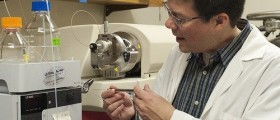
It is estimated that a lymphoma is the third most frequent cancer among children. This cancer originates from the lymphatic system. It can be localized in any lymphatic tissue or organ including lymph nodes, thymus, spleen, adenoids, tonsils, bone marrow etc. All the lymphoma cancers (in both, adults and children) can be classified as Hodgkin and Non-Hodgkin lymphoma.
Hodgkin Lymphoma in Children
In Hodgkin lymphoma, we find cancer cells located in one or more of the lymphatic organs. The most predominant of these cells are called Reed-Sternberg cells. Even though Hodgkin lymphoma predominantly affect adults it can alsoabe found in children.
The symptoms of Hodgkin's lymphoma, in many cases include painless swelling of the lymph nodes in the neck, axilla, groin and chest. Additional symptoms are repeated fever, night sweats, fatigue, decreased appetite, weight loss, itchy skin and frequent infections.
Hodgkin lymphoma in children is diagnosed with the assistance of a complete medical history and physical exam as well as additional tests such as blood and urine tests, chest X ray, CT scan of the chest or the abdomen and biopsy of the affected lymph nodes or the bone marrow.
Treatment for Hodgkin's lymphoma depends on several factors: child's age, general health, medical history, the stage of the disease, potential allergies to medications etc. There are several treatment used for Hodgkin's lymphoma in children; they include chemotherapy, radiation therapy, bone marrow transplant and supportive care. The disease is curable in a majority of cases. The prognosis generally depends on the stage of the disease and response to the treatment.
Non-Hodgkin Lymphoma in Chuldren
This is also a malignant tumor of the lymphatic system. Non-Hodgkin lymphoma can be classified into lymphoblastic non- Hodgkin lymphoma, Burkitt's lymphoma and large cell or diffuse histiocytic non-Hodgkin lymphoma. Lymphoblastic non-Hodgkin lymphoma is usually found in the chest, lymph nodes and may or may not affect the bone marrow and central nervous system. Burkitt's lymphoma most commonly features with a large tumor in the abdomen and may or may not affect the central nervous system. And finally, large cell or diffuse histiocytic non-Hodgkin lymphoma affects the lymphatic system as well as non-lymph structures such as the brain, skin or bones.
Non-Hodgkin lymphoma progresses rapidly. The symptoms may include abdominal mass and associated abdominal discomfort or pain, constipation and loss of appetite. Furthermore, if the tumor is found in the chest patients complain about respiratory problems (breathing difficulties, coughing etc). If the tumor has affected lymph nodes, they become enlarged. The spread of the tumor in bones causes pain and there are also general symptoms such as fatigue, night sweats, weight loss and recurrence of infections.
Diagnosing non-Hodgkin lymphoma does not differ from diagnosing Hodgkin's lymphoma. The treatment for non-Hodgkin lymphoma depends on the same factors as those in Hodgkin lymphoma. It includes chemotherapy, radiation therapy, surgery, bone marrow transplant, spinal taps and supportive care. The prognosis of non-Hodgkin lymphoma is not as good as it is in Hodgkin's lymphoma and it depends on the response to the treatment and the actual stage of the disease.

















Your thoughts on this
Loading...